[ad_1]
Richard Drury
Author’s note: This article was released to CEF/ETF Income Laboratory members on August 12th, 2022.
The Invesco CEF Income Composite Portfolio ETF (NYSEARCA:PCEF) and the Amplify High Income ETF (NYSEARCA:YYY) are the largest, most well-known CEF fund of funds in the market. Both funds invest in dozens of CEFs, offer investors diversified exposure to all major asset classes, and sport high dividend yields. PCEF currently yields 8.2%, and has seen positive dividend growth YTD. YYY currently yields 11.4%, and has seen stable dividends YTD. PCEF’s strategy is simpler, while YYY’s strategy is more complicated, and has been ineffective since inception, leading to consistent capital losses, underperformance, and dividend cuts.
PCEF is a buy, and a fantastic investment opportunity for income investors looking for diversified multi-asset class funds. PCEF’s superior strategy and performance track-record make it a stronger investment relative to PCEF. I see no reason to buy YYY, considering the fund’s many weaknesses, and PCEF’s strengths and advantages.
Strategy and Holdings Comparison – PCEF Winner
Both PCEF and YYY are diversified CEF fund of funds, investing in a wide assortment of CEFs, from all relevant asset classes, but focusing on high-yield bond CEFs. Both are index funds, tracking a specific index with detailed, explicit methodology. Inclusion criteria are quite different between these two funds, however.
PCEF invests in most relevant high-yield, investment-grade, and equity call options CEFs in the market. These three segments encompass most relevant income-producing asset classes in the market, although a couple niche securities are missing, including BDCs and mREITs. As with most index funds, there are some size, liquidity, expenses, and discount / premium screens, but these tend to be quite lax, and exclude a comparatively low number of funds. PCEF is a broad-based index fund, attempting to invest in all relevant income-producing CEFs, with few exceptions.
PCEF’s broad index results in an incredibly well-diversified fund, with investments in over 100 funds from all relevant asset classes, and exposure to thousands of underlying securities. The fund focuses on bonds, but has sizable equity investments. Security weights consider a fund’s NAV and discount, with heavily discounted funds having greater weights. Industry exposures and largest holdings are as follows.
PCEF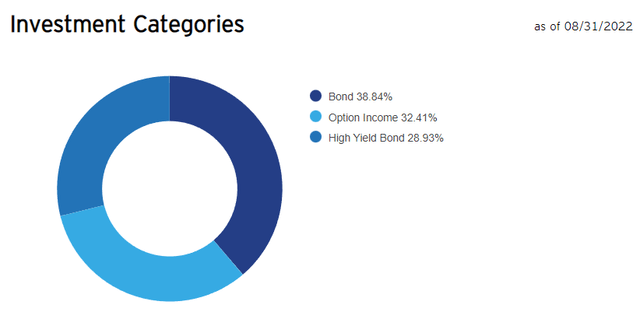
PCEF – Chart by author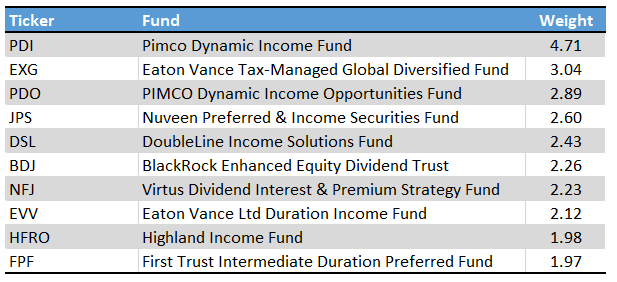
PCEF’s broad index all but precludes the possibility of significant over-performance and underperformance. The fund simply invests in too many funds, securities, and asset classes for performance to be anything but average. Although this is neither a negative nor a positive per se, it is an important fact for investors to consider. Investors could plausibly outperform relative to PCEF by focusing on other funds, or by constructing their own personal portfolio of CEFs. I have a model portfolio of high-yield CEFs which has outperformed relative to PCEF since inception, although with less diversification, and with greater risk, volatility, and losses during downturns. For more aggressive investors, these seem like better options, in my opinion at least.
YYY, on the other hand, invests in 45 CEFs based on their yield, discount to NAV, and liquidity. CEFs with low yields, discounts, or liquidity, are explicitly excluded from the index, and from the fund. Weights take into consideration these three factors as well, so CEFs with above-average yields, discounts, and liquidity have higher weights. YYY invests in a portion of available CEFs, not most as is the case for PCEF.
YYY’s more constrained index results in a less diversified fund when compared to PCEF, with investments in just 45 funds. Diversification remains quite high on an absolute basis, with exposure to thousands of securities from all relevant asset classes and industry segments. So, less diversified than PCEF, but more than diversified enough. As with PCEF, YYY focuses on bonds, with sizable investments in equity.
YYY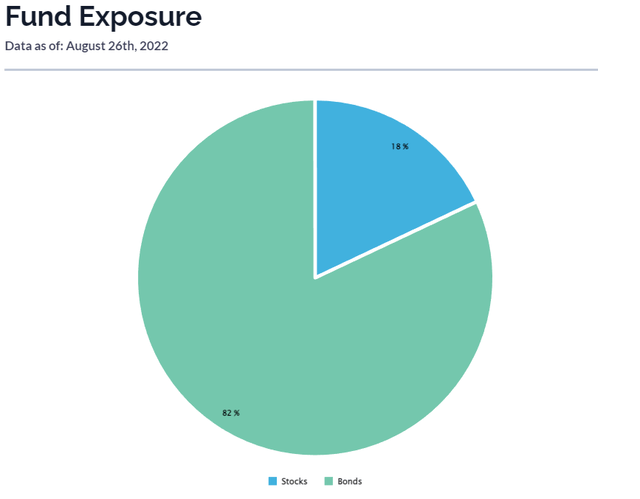
YYY, unlike PCEF, could plausibly significantly outperform or underperform, depending on the effectiveness of its strategy. In general terms, I’m quite wary about YYY’s strategy, as focusing so heavily on discounted and high-yielding CEFs seems unwise. Discounts sometimes indicate weakness and consistent underperformance, but the fund does not take these issues into consideration. Very high yields are generally unsustainable yields, as funds tend to have difficulties generating sufficient income to cover extremely high yields, and as investor demand tends to push down sustainable, but high, yields to more average levels. YYY ignores these issues too. In my opinion and experience, it is possible to successfully pick strong, high-yield CEFs at discounted prices, but doing so requires a bit more care and analysis than done by YYY.
Considering the above, I believe PCEF’s overall strategy to be broadly superior to YYY’s strategy.
Yield Comparison – YYY Winner
High-yield CEFs almost always sport strong distribution yields, significantly higher than that of most asset classes and securities, including equities, bonds, and preferreds. Both PCEF and YYY focus on high-yield CEFs, and so also sport strong distribution yields, significantly higher than average.
YYY further focuses on CEFs with above-average yields, while PCEF invests in most CEFs, regardless of their yield. As such, one would expect YYY to sport a higher yield than PCEF, as is currently the case. YYY currently yields 11.4%, while PCEF yield 8.2%. YYY’s higher yield is an important benefit for the fund and its shareholders, and the fund’s key advantage relative to PCEF. Still, both funds sport strong yields, and significantly higher yields than that of most broad-based asset class index funds.
Seeking Alpha Seeking Alpha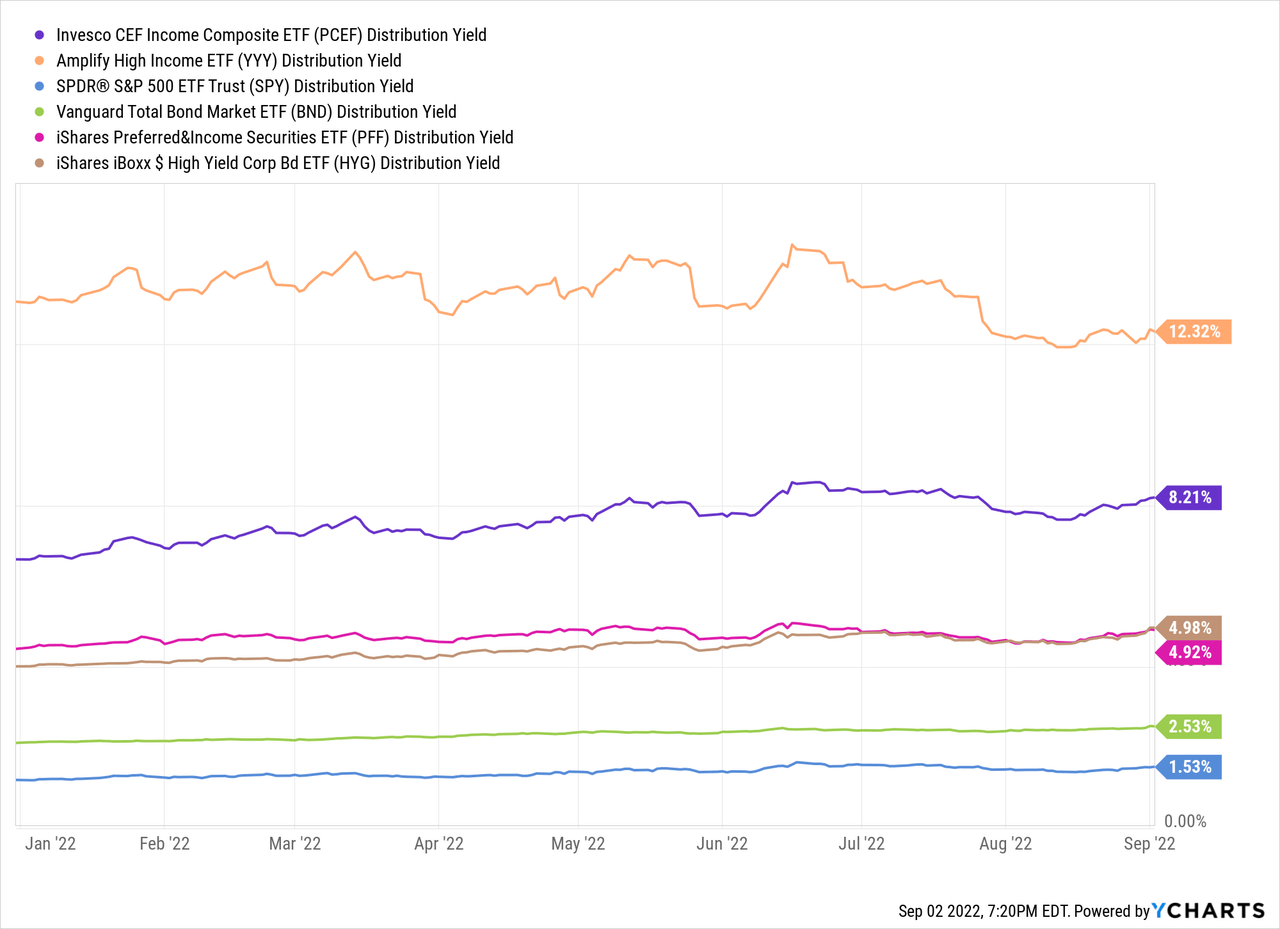
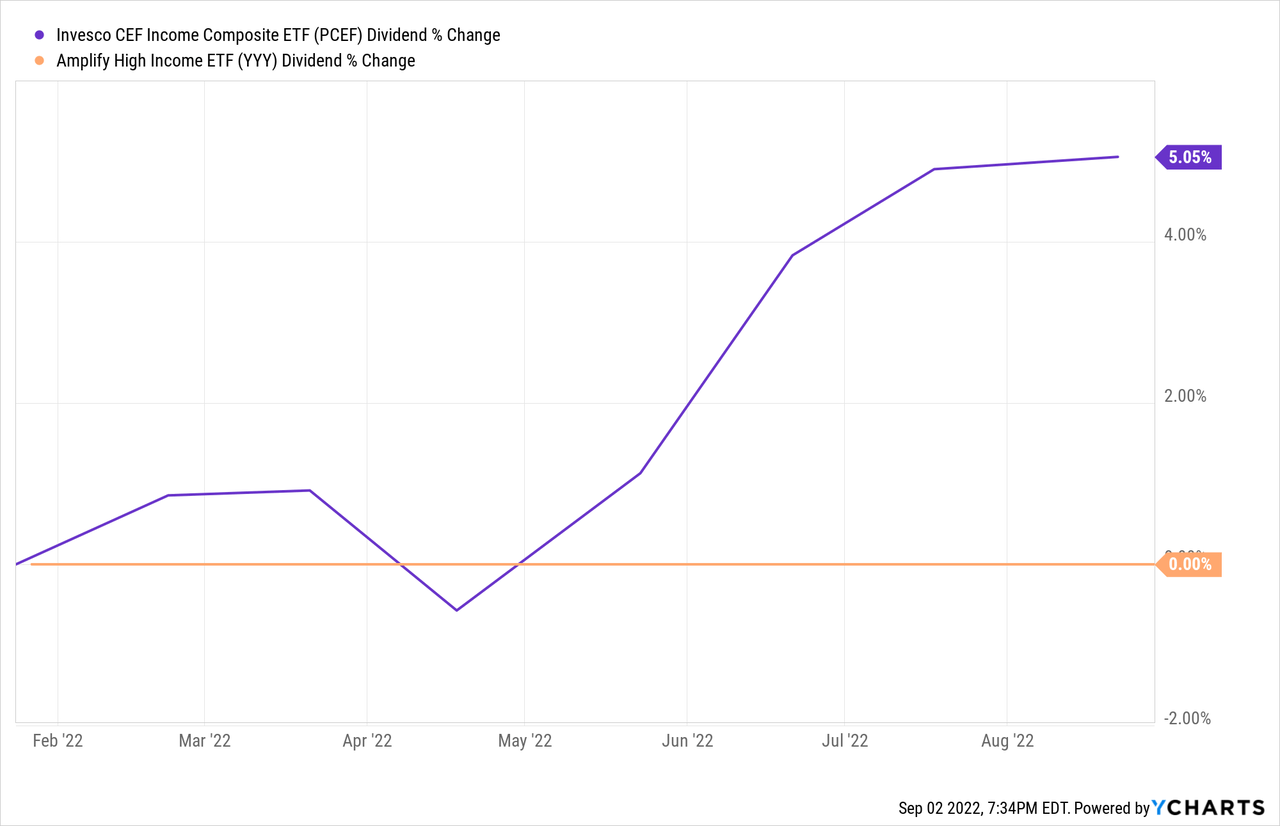
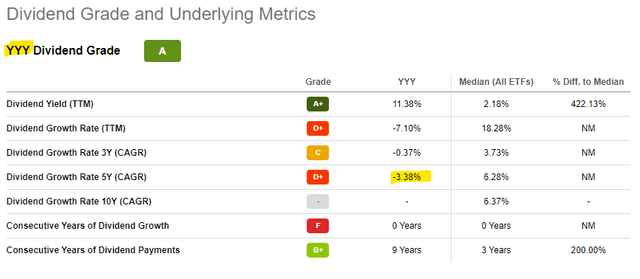
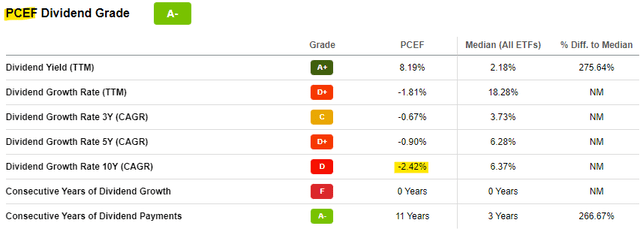
Both funds offer investors strong yields, a significant benefit for investors. YYY’s yield is higher, an important advantage of the fund relative to PCEF.
Price and Discount Comparison – YYY Winner
YYY focuses quite strongly on heavily discounted CEFs. PCEF technically does too, but less so, using laxer criteria, and investing in many funds with small discounts and some with premiums as well. Due to this, both funds invest in discounted CEFs, but the average discount of YYY’s underlying funds is quite a bit higher, 5.0% versus 3.0%, although neither is a particularly high discount regardless.
YYY PCEF 
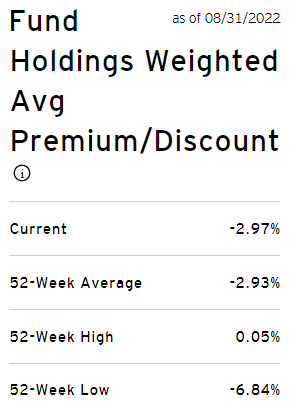
YYY’s larger discount is a benefit for the fund and its investors, and an advantage of the fund relative to PCEF.
Expenses Comparison – PCEF Winner
CEFs tend to be expensive, as do fund of funds. CEF fund of funds should therefore be very expensive, as is the case for both PCEF and YYY.
PCEF charges investors a 0.50% management fee. Its underlying holdings sport an average expense ratio of 1.47%, for a total expense ratio of 1.97%. PCEF’s expenses are quite high on an absolute basis, and significantly higher than average. Index funds tend to charge fees of between 0.05% and 0.50%. Actively-managed funds are generally more expensive, but fees rarely go above 1.0%. PCEF charges almost 2.0%, quite a bit higher than average.
YYY charges investors a 0.50% management fee, same as YYY. Its underlying holdings sport an average expense ratio of 1.76%, for a total expense ratio of 2.26%. YYY’s expenses are quite high on an absolute basis, significantly higher than average, and moderately higher than PCEF expenses.
PCEF’s lower expenses are an advantage relative to YYY, but both funds are still very expensive, significant negatives for both. In my opinion, investors should strongly consider creating their own diversified portfolio of CEFs over an investment in both YYY and / or PCEF. Doing so would reduce expenses for investors, directly boosting returns.
Performance Comparison – PCEF Winner
Both funds have broadly similar performance track-records, behaving as incredibly aggressive, leveraged high-yield corporate bond funds. Performance is consistent with the strategy and holdings of both funds. Both funds focus on bonds, especially high-yield bonds, and CEFs tend to be leveraged. Performance has been particularly poor YTD, as skyrocketing inflation and rising interest rates cause bond prices to decline. Long-term performance looks relatively poor as well, but mostly because recent losses have simply been quite large.
ETF.com – Chart by author
Although the performance of both funds is broadly similar, YYY consistently underperforms relative to PCEF, due to capital losses. YYY has seen capital losses of 43% since inception, almost twice as much as PCEF. Importantly, PCEF’s capital losses are entirely due to the recent increase in interest rates, with the fund seeing (mostly) stable capital levels before 2022. YYY, on the other hand, has seen consistent, long-term capital losses since inception.
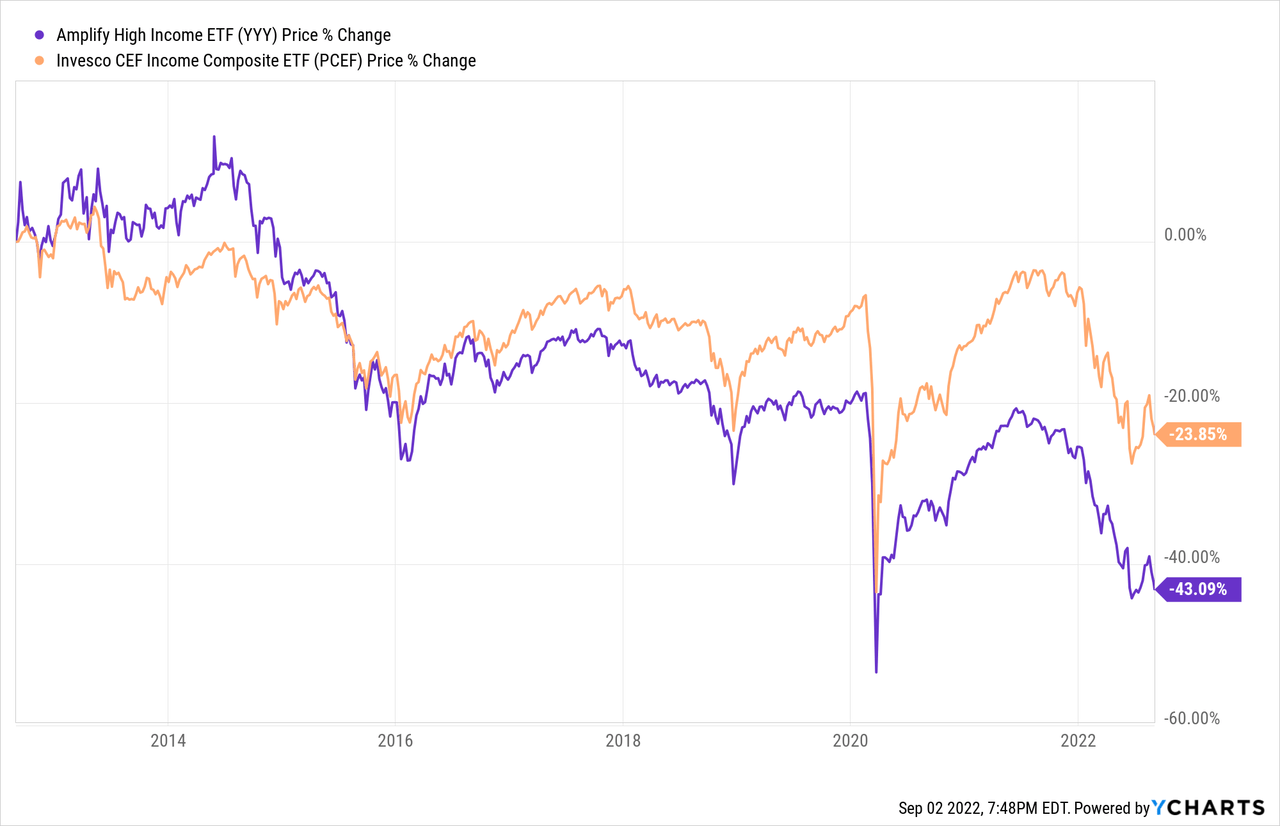
YYY’s ineffective investment strategy and subpar performance track-record are significant negatives for the fund and its shareholders, and the fund’s key disadvantage relative to PCEF. In my opinion, these issues more than outweigh YYY’s higher yield and discount to NAV (of its underlying holdings). As such, PCEF is the superior investment opportunity.
Conclusion – PCEF Clear Winner
PCEF and YYY are two CEF fund of funds. Both funds offer investors diversified exposure to all major asset classes, focusing on bonds. PCEF’s superior strategy and performance track-record make it the broadly superior investment, in my opinion at least. PCEF is a buy, and particularly appropriate for income investors and retirees.
[ad_2]
Source links Google News

